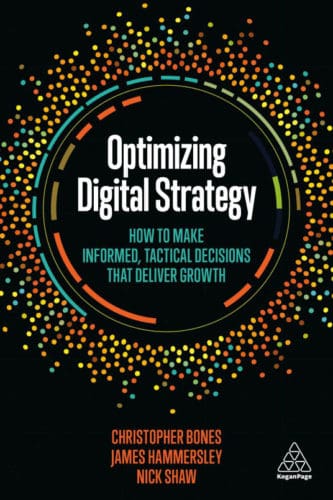Designing digital strategy and optimizing it for best result is critical to success in our online world. Rapidly changing technology offers numerous options for growth, which can quickly get confusing. How do you pick the right strategy and tactics to grow your business? Optimizing Digital Strategy: How To Make Informed, Tactical Decisions That Deliver Growth explores those questions.
Optimizing Digital Strategy
Digital strategy can make or break a business. In Optimizing Digital Strategy: How To Make Informed, Tactical Decisions That Deliver Growth, authors Christopher Bones, James Hammersley, and Nick Shaw look to provide the knowledge needed to succeed in our fast-moving digital world. Sadly, they fall short of this goal.
From the beginning, it’s hard to know what audience this book is intended for. While it starts with advice to digital marketers, it jumps to talking about issues only relevant to organizational leaders. Then it hops back and forth with content that some within an organization might find useful, while it’s meaningless to others. It’s really unclear who this book is for, and it’d be a waste of time for people at many levels.
The topics covered also jump all over the place. Some of the information provided touches on more advanced topics like AI, personalization, and optimization but a large portion of the book talks about topics that are really Digital Marketing 101. If you’re looking to optimize, these things are already in place, otherwise you’d be putting the cart before the horse. For this reason, it’s not really relevant for such a book and makes it even more confusing as to who the target audience is.
Call The Editor
Explanations of concepts are much longer than they need to be. It seems the authors are looking to stretch the book length to meet a page minimum, as they go on and on about ideas that don’t really require that much explanations. It feels as if you’re going in circles, explaining the same thing over and over.
The customer experience stories are way too drawn out too. In almost every case, the point could have been proven with 1/4 the wording. Again it feels like they’re writing words for the sake lengthening the book, not better explaining their story.
Reading is made difficult by TONS of run-on sentences. Here’s one such example of the length that much of the wording grows throughout the book. This is a single sentence:
In our view, there is a continuum of engagement online from activity that looks very similar to that for TV/radio, outdoors and much of print (addressed at consumers at large or against a specific demographic definition to raise awareness of the brand, such that when the time arises they would consider purchasing the product or service) to promotional activity close to the point of purchase that offline you would see in some print leaflets though the mail, and in-store/in-venue promotional activity (the encouragement of people shopping to opt for your brand or service at a stage when they have the intention to transact).
A lot of additional editing would make for a much easier read. Cutting out unneeded wording and drawn out explanations would drop the size of this book substantially.
Staying on-topic seems to be a challenge for the authors also. At one point, the book takes a wild detour into business ethics. It seems irrelevant to a book on digital marketing and doesn’t connect with the rest of the content.
Negative Nancy
Saying one thing and then negating your own claim is another issue that pops up.
They continuously slam social media as an ineffective tool, as they’ve been unable to produce great results for their own clients. Then they go on to present a case study where their own client increased event signups by 46% using social media. Seems pretty silly to say something is ineffective when it’s brought about nearly a 50% increase in results for your business.
The entire book has a negative tone. It’s a bit doom and gloom, and a bit depressing. A great example comes from the the last line of the book:
After all, the likeliest biggest barrier to success in digital isn’t technology, it’s the organization – and reducing the possibility of shooting yourself in the foot is an action completely within your own control.
We don’t tend to read business books looking to be brought down. Cheer up guys.
Missing The Mark
Overall, Optimizing Digital Strategy misses the mark. There are a few pieces of decent advice, but the majority isn’t useful to those with experience in digital marketing. The intended audience is unclear, the topics seem random, it needs a lot of editing to remove run-on sentences and wordiness, and the tone is far too negative. There are far too many good books on digital strategy to waste your time reading one that’s confusing and offers little value.
If you’re looking for good books on digital marketing strategy and how to drive success, check out some of the other books I have recommended in the past. If you’d still like to read Optimizing Digital Strategy: How To Make Informed, Tactical Decisions That Deliver Growth despite all the issues, you can grab a copy here on Amazon.

